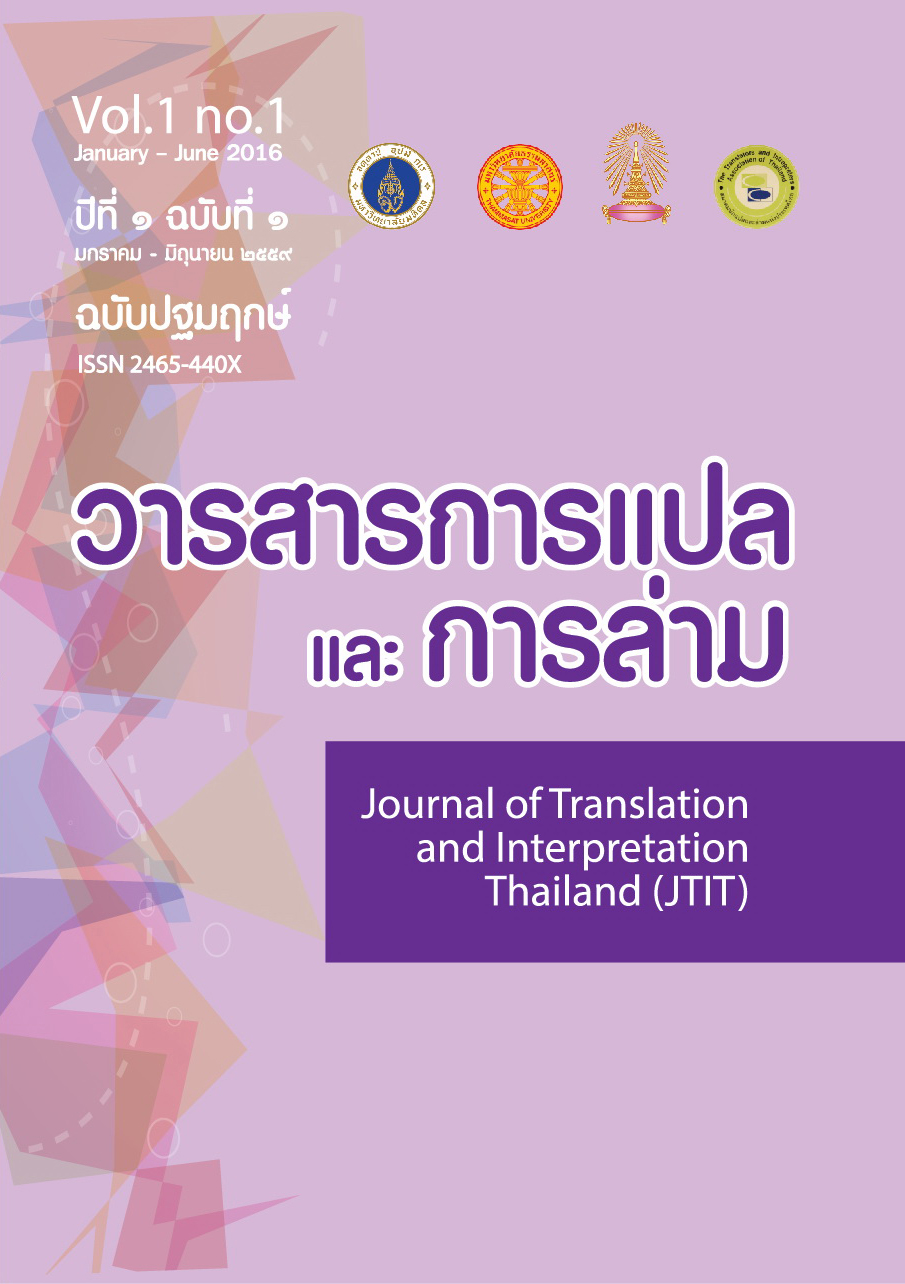ปัญหาการแปลที่เกิดจากหน่วยสร้างกริยาเรียงในภาษาไทย
Main Article Content
บทคัดย่อ
บทความนี้กล่าวถึงปัญหาหลักข้อหนึ่งในการแปลจากภาษาไทยเป็นภาษาอังกฤษที่เกิดจากหน่วยสร้างกริยาเรียงในภาษาไทย ซึ่งไม่ปรากฏว่ามีหน่วยสร้างแบบนี้ในภาษาอังกฤษ แม้หน่วยสร้างกริยาเรียงภาษาไทยจะแสดงลักษณะของเหตุการณ์ได้หลากหลาย หน่วยสร้างกริยาเรียงที่แสดงเหตุการณ์บางลักษณะเท่านั้นที่ดูจะเป็นปัญหาในการแปลสำหรับผู้เรียน คือหน่วยสร้างกริยาเรียงแสดงเหตุการณ์ต่อเนื่องกันโดยไม่มีช่วงห่างที่สังเกตได้และหน่วยสร้างกริยาเรียงแสดงเหตุการณ์ที่เกิดขึ้นพร้อมกัน การสื่อความหมายของหน่วยสร้างกริยาเรียงได้อย่างเหมาะสมในภาษาอังกฤษทำได้โดยการประยุกต์ใช้ทฤษฏีการแปลแบบตีความ (Interpretive Theory) และใช้หลักการของแนวคิดเกี่ยวกับการคิดเพื่อที่จะพูด (Thinking for Speaking)
Article Details
ประเภทบทความ
บทความ
เอกสารอ้างอิง
กิ่งกาญจน์ เทพกาญจนา. (2553). “หน่วยสร้างกริยาเรียงต้นแบบในภาษาไทย.” ใน หน่วยสร้างที่มีข้อขัดแย้งในไวยากรณ์ไทย. (พิมพ์ครั้งที่ 2). 66-173. อมรา ประสิทธิรัฐสินธุ์, บรรณาธิการ. กรุงเทพฯ: โรงพิมพ์จุฬาลงกรณ์มหาวิทยาลัย.
ปรีมา มัลลิกะมาส. (2556). การแปลกับการสอนภาษาอังกฤษ. (พิมพ์ครั้งที่ 3). กรุงเทพฯ: โครงการเผยแพร่ผลงานวิชาการ คณะอักษรศาสตร์ จุฬาลงกรณ์มหาวิทยาลัย.
เลเดแรร์, มารีอานน์. (2540). การแปลคือการถ่ายทอดความหมาย มิใช่การถ่ายภาษา. แปลโดย จิระพรรษ์ บุณยเกียรติ. ใน ศาสตร์การแปล: รวมบทความเชิงทฤษฎีและปฏิบัติ, 1-43. กรุงเทพ ฯ: โครงการศูนย์การแปล คณะศิลปศาสตร์ มหาวิทยาลัยธรรมศาสตร์.
อมรา ประสิทธิ์รัฐสินธุ์. (2545). ความแตกต่างทางโครงสร้างของภาษาไทยกับภาษาอังกฤษที่มีผลต่อการแปล. วารสารรามคำแหง, 19(3), 68-82.
Delisle, J. (1998). Translation: An interpretive approach. (Patricia Logan & Monica Creery, Trans.). Ottawa, Canada: University of Ottawa Press.
Iwasaki, S., & Ingkaphirom, P. (2005). A reference grammar of Thai. Cambridge, UK: Cambridge University Press.
Levelt, W.J.M. (1989). Speaking: From intention to articulation. Cambridge, MA : MIT Press.
Pawley, A. (1987). Encoding events in Kalam and English: Different logics for reporting experience. In Russell Tomlin (Ed.), Coherence and grounding in discourse (pp. 335-336). Amsterdam, Netherlands: John Benjamins.
Slobin, D. (1987). Thinking for speaking. Proceedings of the Thirteenth Annual Meeting of the Berkeley Linguistics Society, 435-445.
_____. (1991). Learning to think for speaking: Native language, cognition and rhetorical style. Pragmatics, 1(1), 7-25.
_____. (1996). From “thought and language” to “thinking for speaking”. In J.J. Gumperz & S. C. Levinson (Eds.), Rethinking linguistic relativity (pp. 70-96). Cambridge, UK: Cambridge University Press.
_____. (2003). Language and thought online: Cognitive consequences of linguistic relativity. In D. Gentner & S. Glodin-Meadow (Eds.), Language in mind: Advances in the study of language and thought (pp. 157-192). Cambridge, MA: MIT Press.
Talmy, L. (1991). Path to realization: A typology of event conflation. Berkeley Working Papers in Linguistics, 17, 480-519.
ปรีมา มัลลิกะมาส. (2556). การแปลกับการสอนภาษาอังกฤษ. (พิมพ์ครั้งที่ 3). กรุงเทพฯ: โครงการเผยแพร่ผลงานวิชาการ คณะอักษรศาสตร์ จุฬาลงกรณ์มหาวิทยาลัย.
เลเดแรร์, มารีอานน์. (2540). การแปลคือการถ่ายทอดความหมาย มิใช่การถ่ายภาษา. แปลโดย จิระพรรษ์ บุณยเกียรติ. ใน ศาสตร์การแปล: รวมบทความเชิงทฤษฎีและปฏิบัติ, 1-43. กรุงเทพ ฯ: โครงการศูนย์การแปล คณะศิลปศาสตร์ มหาวิทยาลัยธรรมศาสตร์.
อมรา ประสิทธิ์รัฐสินธุ์. (2545). ความแตกต่างทางโครงสร้างของภาษาไทยกับภาษาอังกฤษที่มีผลต่อการแปล. วารสารรามคำแหง, 19(3), 68-82.
Delisle, J. (1998). Translation: An interpretive approach. (Patricia Logan & Monica Creery, Trans.). Ottawa, Canada: University of Ottawa Press.
Iwasaki, S., & Ingkaphirom, P. (2005). A reference grammar of Thai. Cambridge, UK: Cambridge University Press.
Levelt, W.J.M. (1989). Speaking: From intention to articulation. Cambridge, MA : MIT Press.
Pawley, A. (1987). Encoding events in Kalam and English: Different logics for reporting experience. In Russell Tomlin (Ed.), Coherence and grounding in discourse (pp. 335-336). Amsterdam, Netherlands: John Benjamins.
Slobin, D. (1987). Thinking for speaking. Proceedings of the Thirteenth Annual Meeting of the Berkeley Linguistics Society, 435-445.
_____. (1991). Learning to think for speaking: Native language, cognition and rhetorical style. Pragmatics, 1(1), 7-25.
_____. (1996). From “thought and language” to “thinking for speaking”. In J.J. Gumperz & S. C. Levinson (Eds.), Rethinking linguistic relativity (pp. 70-96). Cambridge, UK: Cambridge University Press.
_____. (2003). Language and thought online: Cognitive consequences of linguistic relativity. In D. Gentner & S. Glodin-Meadow (Eds.), Language in mind: Advances in the study of language and thought (pp. 157-192). Cambridge, MA: MIT Press.
Talmy, L. (1991). Path to realization: A typology of event conflation. Berkeley Working Papers in Linguistics, 17, 480-519.


